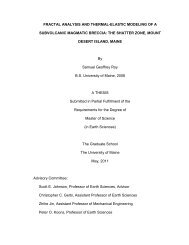Jumars, P.A. - University of Maine
Jumars, P.A. - University of Maine
Jumars, P.A. - University of Maine
You also want an ePaper? Increase the reach of your titles
YUMPU automatically turns print PDFs into web optimized ePapers that Google loves.
NEW SPECIES OF NORTH PACIFIC DORVILLEID POLYCHAETES 121<br />
Meiodorvillea apalpata sp . nov .<br />
(Fig . 10)<br />
Material examined . The holotype and one posterior fragment from SIO J14<br />
(AHF Poly . 1086-7) were externally examined, as was an individual from<br />
SIO J22 (paratypes, AHF Poly . 1089) . One complete and two halved specimens<br />
from SIO H22 (paratypes, AHF Poly . 1088) were similarly treated before the<br />
jaws from one <strong>of</strong> the halved specimens were dissected out and lost in mounting .<br />
The other anterior half was mounted whole after clearing .<br />
Description . The holotype measures 2 .8 mm long and 0 .14 mm wide for 41<br />
setigers plus prostomium, peristomium, and pygidium . A pair <strong>of</strong> short, clavate<br />
antennae insert dorsally on the pear-shaped prostomium (Fig . 10A) such that<br />
transverse and longitudinal lines drawn through their insertions would divide<br />
the wider posterior half <strong>of</strong> the prostomium into sixths . Palps are lacking. Of the<br />
two peristomial rings, the second is the longer and the wider . Dorsal cirri are<br />
absent ; ventral cirri are lappet like and transparent . They are present on setigers<br />
2-14 and are reduced or absent thereafter . Neuropodia (Fig . 10E) consist <strong>of</strong><br />
two apparent parts, a dorsal, conical, opaque portion and a ventral, flattened<br />
transparent portion . The neuropodia are biacicular, one acicula being found in<br />
each <strong>of</strong> the two parts . Setae above the dorsal aciculae include gradually<br />
tapering capilleries and geniculate setae, though one or the other <strong>of</strong> these setal<br />
types may be absent in a particular parapodium . Geniculate setae (Fig . 10D)<br />
have smooth bases <strong>of</strong> constant diameter and a flattened, basally denticulate,<br />
distal portion . The first, largest tooth on this "pennant" appears to be the only<br />
vestige <strong>of</strong> the short tine <strong>of</strong> a furcate seta . Setae below the dorsal acicula are<br />
compound heterogomph (Fig . 10C) with a smooth, rounded, mitten-like, distal<br />
end <strong>of</strong> the shaft . The appendage is lanceolate or elongate lanceolate and lacks<br />
denticulation . The pygidium is crown shaped (Fig . 10B) . Below the anus is a<br />
low, conical projection . Above the anus are numerous small papillae and two<br />
clavate appendages . Laterally, two additionall, smaller, clavate appendages are<br />
evident .<br />
The mandibles (Fig . 10F) are butterfly shaped and lack obvious denticulation<br />
. The maxillae (Fig . 10G) consist <strong>of</strong> a relatively large pair <strong>of</strong> posteriorly<br />
fused carriers free from the two basal plates, which are also posteriorly fused .<br />
No free denticles remain .<br />
The gut is apparently empty in all available specimens .<br />
Distribution . The species is known only from the Coronado Sea Fan region<br />
<strong>of</strong> the San Diego Trough in silty mud under 1223-1224 m <strong>of</strong> water .<br />
Genus Exallopus gen . nov.<br />
Type-species. Exallopus cropion sp . nov .<br />
Diagnosis. The prostomium is depressed hemispherical . Antennae and palps<br />
are well developed and <strong>of</strong> approximately equal lengths . The palps are<br />
biarticulate, and the constriction near the bases <strong>of</strong> the antennae suggests<br />
articulation also . Dorsal cirri are absent . Capillary and compound, heterogomph<br />
setae are present after the first setiger . Setae in the first parapodium are thicker<br />
by a factor <strong>of</strong> about two and one half than any <strong>of</strong> those following and are
















